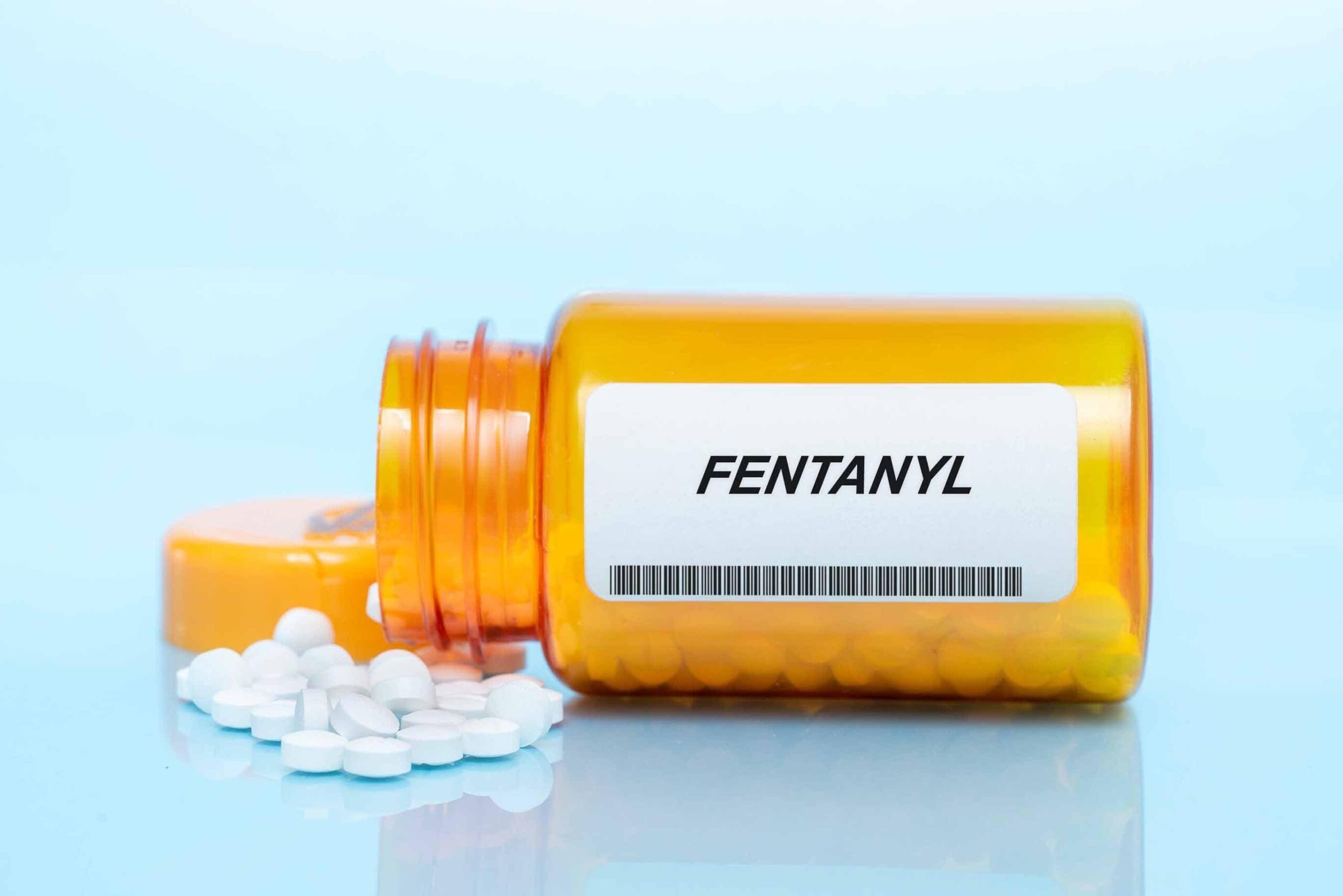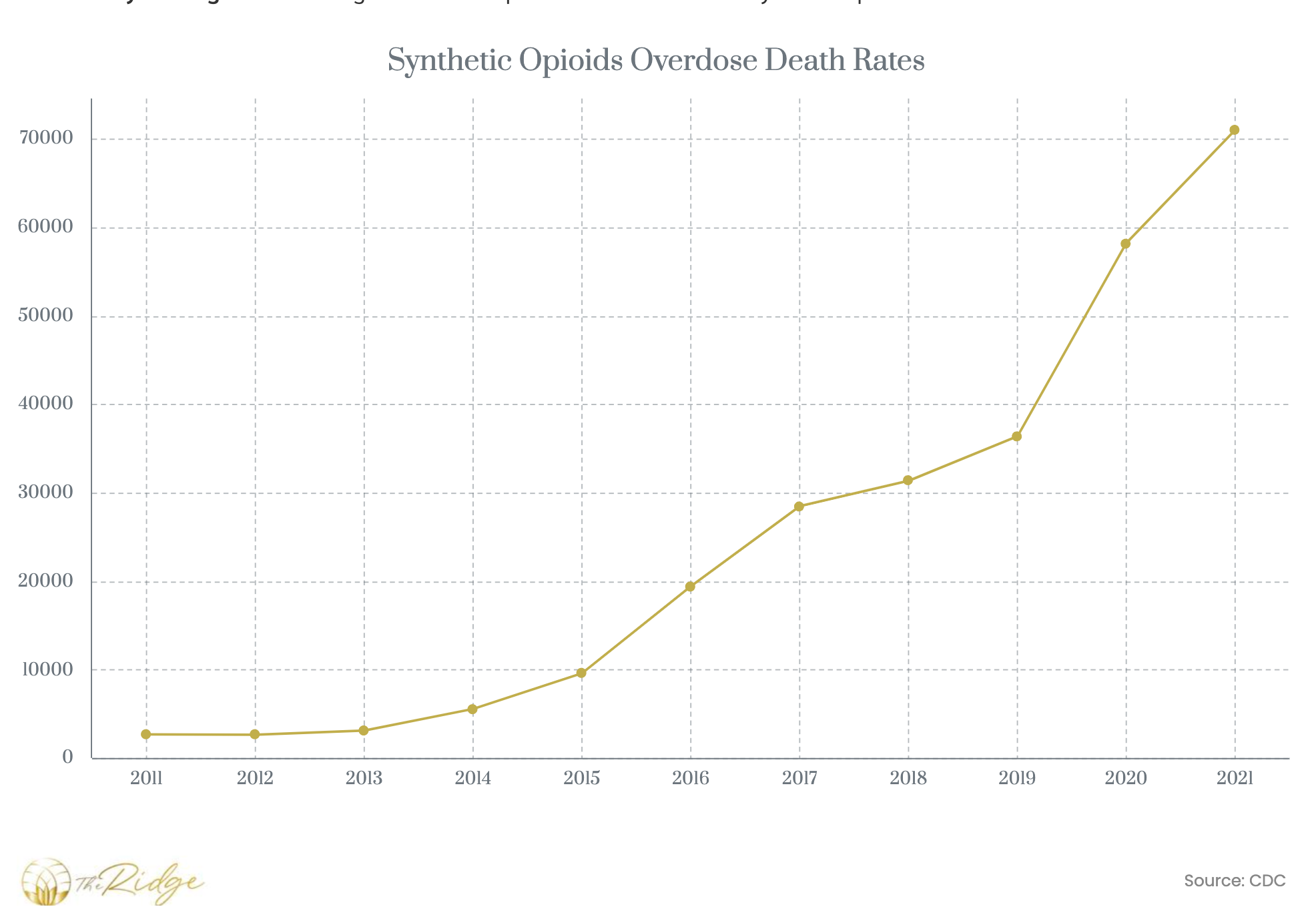Since the early 2000s, more than a million Americans have died of overdoses–mostly due to opioids. There are two broad categories of opioids–legally manufactured medications and illicit narcotics. Opioid medications–morphine, oxycodone, hydrocodone, and fentanyl, gained popularity in the medical field during the 90s as a treatment for severe pain. It’s specifically used in patients who have cancer and have undergone surgery. In the 2000s, doctors started prescribing opioids for back and joint pain, despite the increasing overdose deaths in 1999.
On the other hand, illicit narcotics involve synthetic opioids, such as heroin and also fentanyl. In recent years, these illicit narcotics have become the reason for the United States’ worst drug crisis in history. According to the National Center for Health Statistics, more than 1,500 people die per week from taking some type of opioid. From 2011 to 2021, fatal overdoses from clandestinely produced fentanyl and fentanyl analogs, and law enforcement encounters have increased. In March 2022, the fatalities of drug overdoses over a 12-month period reached an estimated number of 110,360 deaths. As the illicit drug supply changed over the pandemic, more fentanyl-associated deaths occurred.
The scariest thing about fentanyl is that you can’t see it, feel it, smell it, or taste it. To see how dangerous fentanyl is and how it contributes to the U.S. opioid crisis, take a look at the facts and statistics below.
Key Takeaways
- In 2021, the DEA Laboratory found that 42% of pills they seized contained at least .02 to 5.1mg, which is more than twice the lethal dose, of fentanyl. In 2022, DEA seized fentanyl powder and pills that contained 23% and 7% of xylazine, respectively.
- The overdose risk of fentanyl can be measured in micrograms (mcg) and milligrams (mg). The range of overdose risk starts at 25mcg or 0.025mg (non-fatal) to 2000mcg or 2mg (death). Anything beyond 150mcg or 0.15mg poses significant to extreme risk to individuals consuming fentanyl. It only takes one kilogram of fentanyl to kill about half a million people.
- Illicit fentanyl and synthetics account for 77.14% of adolescent overdose deaths in 2021. This rate is extremely high compared to other substance types. There were only 13.26% of deaths related to benzodiazepines, 9.77% for methamphetamines, 7.33% for cocaine, 5.76% for prescription opioids, and 2.27% for heroin.
- In a recent study conducted by NYU, 83% of individuals in New York inject drugs without knowing that the substance they’re using is laced or contaminated with fentanyl. When these individuals were tested, 54% of them tested positive for fentanyl (no heroin), and 46% tested positive for both fentanyl and heroin.
- In 2021, fentanyl is responsible for the highest overdose death rate among people between ages 25 and 34 with a rate of 40.8 per 100,000 people. The rate, however, is higher among individuals ages 35 to 44, as they have an overdose death rate of 43.5 per 100,000. These rates are significantly higher than methamphetamines with only 15.4 and 20.3 per 100,000, respectively.
- Despite what is known among drug users, fentanyl is not safer than morphine. Only 1mg of fentanyl can have the same potency as 50mg of heroin, 67mg of oxycodone, and 100mg of morphine.
Scale Of The Crisis
The first wave of the opioid crisis in the United States started in the 1990s with the increase in opioid prescriptions. As the years went by, the crisis became worse. Here are facts and figures regarding the crisis:
- Since 2019, the United States has had a diverse flow of fentanyl. The fentanyl crisis started in 2014. Since then, the flow of supply has become more diverse, with the introduction of additional source countries into the global supply chain of fentanyl, fentanyl-related substances, and fentanyl precursors.
- China remains the primary source of fentanyl and other fentanyl-related substances. The substances are usually trafficked via international mail and express consignment operations environment.
- Smuggled pills and tablets across the U.S.-Mexico border contain less than 10% concentration of fentanyl. Mexico is producing increased quantities of fentanyl tablets and tablets laced with illicit fentanyl. Smuggled fentanyl tablets from Mexico are often in low concentration, but high-volume loads. Kilogram seizures often contain less than 10% of fentanyl concentration.
- In 2021, there were a total of 22,774 non-fatal opioid overdose in-patient hospitalizations. This is equivalent to an annual rate of 19.0 per 100,000 individuals.
- In 2021, there were a total of 71 thousand drug overdose deaths involving synthetic opioids, such as fentanyl and fentanyl analogs. This is a huge number compared to the total of 730 synthetic opioid-related deaths in 1999.
- In 2022, about 23% of DEA’s fentanyl powder samples and 7% of fentanyl pills contained xylazine. The DEA Laboratory System reported that the fentanyl pills and powder they seized contained xylazine, which is a powerful sedative used in veterinary practice.
- From 2015 to 2019, deaths from methamphetamine overdoses almost tripled among ages 18 to 64. This increase in numbers is mostly due to methamphetamine and cocaine being more dangerous as they get contaminated with fentanyl.
- Between late 2013 and late 2014, there were about 700 fentanyl-related deaths in the United States. The DEA, however, mentioned that this number could be underestimated due to varying state reporting techniques and deaths attributed to heroin.
- The drug use rate among adolescents between 2010 to 2020 is 30.2% and 30.4%, respectively. These rates are considered generally stable, and these adolescents are 10th graders reporting illicit drug use in the past 12 months.
- The rate of increase in overdose deaths among adolescents from 2020 to 2021 is 11.48%. This rate is lower compared to the rate of increase from 2019 to 2020, which was 29.48%.
- In 2021, American Indian and Alaska Native adolescents experienced the highest overdose rate with 11.79 per 100,000. This is followed by Latinx adolescents with a rate of 6.98 ODs per 100,000 adolescents.
- In a 2020 study, 337 deaths out of 815 methamphetamine-related deaths involved the combination of meth and fentanyl/fentanyl analogs. This number constituted the largest increase from 2013 to 2018. In addition, meth-fentanyl/FA deaths are significantly higher than the number of methamphetamine-only deaths.
- For people who don’t have insurance, the average out-of-pocket cost per naloxone increased by 506% from 2014 to 2018. On the opposite side, the average out-of-pocket cost per naloxone prescription for people with health insurance has declined by 26%.
- In 2019, older women ages 75 to 84 had the highest rate of intentional drug overdose. Age-adjusted intentional drug overdose deaths increased among certain subgroups in 2019, with older women ages 75 to 84 as the highest and young men ages 15 to 24 as the lowest.
- In 2021, it was discovered that 1 in 5 pharmacies restricts access to buprenorphine. In a study, 183 pharmacies, or 20% of the total 921 pharmacies indicated that they wouldn’t dispense buprenorphine. The medication is incredibly crucial for people with opioid use disorder.
Dangers Of Fentanyl
Fentanyl is one of the most recent additions to the opioid epidemic. This synthetic opioid is considered one of the most lethal substances circulating the streets. Here are facts and figures to learn how dangerous fentanyl is:
- Fentanyl is a highly potent substance with 1mg having the same potency as 50mg of heroin. One milligram of fentanyl also has the same potency as 67mg of oxycodone and 100mg of morphine.
- The considered potential lethal dose of fentanyl is about 2mg. According to the DEA, only 2mg of fentanyl can be lethal, depending on the person’s body size, past usage, and tolerance.
- About 42% of pills tested by the DEA contained at least 2mg of fentanyl. A 2021 analysis conducted by the DEA found that counterfeit pills contained traces of at least .02 to 5.1mg, which is more than twice the lethal dose, of fentanyl.
- One kilogram of fentanyl can potentially kill 500,000 individuals. Fentanyl is typically distributed by drug trafficking organizations. They distribute the substance by kilogram.
- Fentanyl contributed to plenty of high-profile deaths in the early 21st century. Some of these deaths include rapper Mac Miller, and singer-guitarists Prince and Tom Petty.
- One thousand micrograms of fentanyl is very likely to stop someone from breathing and kill a person. Each microgram of fentanyl poses an estimated overdose risk, depending on dose size and opioid tolerance. Consuming 25 micrograms of fentanyl is considered non-fatal. Fentanyl consumed in 50 to 100 micrograms poses modest and moderate risks; significant risk is associated with 150 micrograms; 250 to 400 micrograms of fentanyl is considered high and extreme overdose risk. Death is likely for 700 micrograms; 1000 micrograms is considered “death near certain,” while 2000 micrograms is considered deadly.
- Patients who have multi-hour open-heart surgeries might need 250 to 500 micrograms of fentanyl. In some extreme cases, a patient may get about 700 micrograms of fentanyl during the surgery.
- About 90,000,000,000,000,000 fentanyl molecules can be found in a 50-microgram dose of fentanyl. Fentanyl has “hot spots” or a part of the mixture that has an unexpectedly greater amount of the substance. These hot spots exist because of the chemical nature of fentanyl molecules, which can’t be mixed or cut.
- There are 9 fentanyl-related substances classed under Schedule I. The DEA categorizes drugs into five different schedules under the Controlled Substances Act, with Schedule I class having the highest potential for abuse. These 9 fentanyl-related substances include isomers, esters, ethers, and salts.
- In 2022, it was found that fentanyl is only tested for in 5.1% of overdose ED visits. The positivity rate of fentanyl is 41.7%, which is more than three times greater than opiates (13.5%).
- In 2021, fentanyl deaths were highest among people ages 25 to 34 (40.8 per 100,000) and ages 35 to 44 (43.5 per 100,000). This is followed by methamphetamine, with a rate of 15.4 and 20.3, respectively; and cocaine with 11.5 and 14.9.
- Fentanyl-related deaths among the standard population increased from 5.7 per 100,000 in 2016 to 21.6 per 100,000 in 2021. The rate of increase from 2019 to 2020 was 55.0%, and 24.1% from 2020 to 2021.
- The fentanyl-related overdose death rate among males is 31.3. The death rate among males is 2.6 times higher than the rate among females (11.9) in 2021.
- Fentanyl-involved fatalities among adolescents in 2021 have reached a total number of 884 (4.23 per 100,000 adolescents). In 2019, there were only fentanyl-related 253 fatalities, or 1.21 per 100,000 adolescents. This increased to 680 or 3.26 per 100,000 adolescents in 2020.
- Fentanyl was identified in 77.14% of adolescent overdose deaths in 2021. This is followed by benzodiazepines (13.26%), methamphetamine (9.77%), cocaine (7.33%), prescription opioids (5.76%), and heroin (2.27%).
- Out-of-hospital deaths associated with fentanyl increased from 46.6 per million in 2016 to 178.0 per million in 2021–an increase rate of 282%. These out-of-hospital fentanyl-related deaths primarily increased during the early pandemic period.
- In 2021, 83.0% of fentanyl overdose-related deaths occurred outside of hospitals. This rate is higher compared to 76.1% of opioid overdoses without fentanyl and 67.8% of overdose deaths without opioid involvement.
State Information
Fentanyl seems to become a huge problem in plenty of states since 2017. Here is some information on Alabama, Alaska, Nevada, California, Ohio, New York, South Carolina, and Vermont.
Opioid Overdose Deaths by State, 2021
| Synthetics Opioids (Mostly Fentanyl) Overdose Deaths | Natural Opioids Overdose Deaths * | |
| United States | 70,603 | 13,620 |
| Alabama | 847 | 148 |
| Alaska | 153 | 72 |
| Arizona | 1,753 | 261 |
| Arkansas | 313 | 100 |
| California | 6,060 | 1,034 |
| Colorado | 973 | 286 |
| Connecticut | 1,285 | 187 |
| Delaware | 411 | 48 |
| District of Columbia | 330 | 26 |
| Florida | 5,358 | 1,013 |
| Georgia | 1,448 | 497 |
| Hawaii | 53 | 29 |
| Idaho | 160 | 87 |
| Illinois | 2,706 | 507 |
| Indiana | 2,011 | 441 |
| Iowa | 211 | 65 |
| Kansas | 351 | 109 |
| Kentucky | 1,716 | 409 |
| Louisiana | 1,174 | 283 |
| Maine | 497 | 71 |
| Maryland | 2,301 | 276 |
| Massachusetts | 2,178 | 198 |
| Michigan | 2,285 | 413 |
| Minnesota | 882 | 168 |
| Mississippi | 475 | 134 |
| Missouri | 1,445 | 188 |
| Montana | 72 | 28 |
| Nebraska | 90 | 38 |
| Nevada | 369 | 222 |
| New Hampshire | 349 | 38 |
| New Jersey | 2,498 | 337 |
| New Mexico | 605 | 142 |
| New York | 4,527 | 972 |
| North Carolina | 3,065 | 468 |
| North Dakota | 57 | 17 |
| Ohio | 4,183 | 420 |
| Oklahoma | 337 | 115 |
| Oregon | 536 | 175 |
| Pennsylvania | 3,782 | 619 |
| Rhode Island | 343 | 44 |
| South Carolina | 1,507 | 372 |
| South Dakota | 33 | 13 |
| Tennessee | 2,796 | 588 |
| Texas | 1,858 | 623 |
| Utah | 202 | 185 |
| Vermont | 203 | 31 |
| Virginia | 2,064 | 290 |
| Washington | 1,218 | 300 |
| West Virginia | 1,189 | 206 |
| Wisconsin | 1,300 | 302 |
| Wyoming | 44 | 25 |
Alabama
- In Alabama, 46% law enforcement respondents considered fentanyl and other opioids as the greatest drug threat. About 44% of respondents think methamphetamine is the greatest drug threat, other than fentanyl. These two are followed by heroin (4%), cocaine (2%), marijuana (2%), and controlled prescription drugs (2%).
- In the same state, more than half (78) of law enforcement respondents believe that the availability of fentanyl and other opioids is increasing. Fentanyl and other opioids come first on the list; followed by methamphetamine (71), heroin (59), marijuana (42), controlled prescription drugs (24), and cocaine (22).
- Fentanyl and other opioids were ranked as the 2nd greatest contributor to violent crime (17%) and property crime (11%) in Alabama. For 47% of respondents, methamphetamine is the number one contributor to violent crime rates. About 66% associate methamphetamine with property crime in the state.
- Fentanyl and other opioids also come 2nd in terms of treatment centers’ greatest drug threat. About 24 drug rehab centers believe that fentanyl is the second greatest drug threat, almost tied with methamphetamine (25).
Alaska
- In 2021, synthetic opioids, such as fentanyl, increased the overdose death rate in Alaska by 150%. The general drug overdose rate in Alaska had a 74% increase in 2021. This was exacerbated by synthetic opioids (150%) and methamphetamines (148%).
California
- In California, the percentage of overdose deaths among homeless people involving fentanyl rose from 12.5% in 2018 to 58.4% in 2021. The percentage of deaths involving fentanyl has increased almost five-fold; starting from the bottom of the list to nearly reaching the level of methamphetamine in three years.
- The state of California is planning to include an additional $141.3 million in the Opioid Settlements Fund in the Governor’s Budget. This significant adjustment is made to support the Naloxone Distribution Project.
Ohio
- In Ohio, it’s determined that there are at least 5 suspected overdose deaths within 12 hours on June 1st. A medical examiner from Cuyahoga County issued a public health alert on June 2, mentioning that drug overdose continues to be a problem within the community.
- In Franklin County, overdose deaths involving fentanyl continued to rise from 76% in 2017 to 89% in 2021. This is followed by cocaine with 36% in 2017 to 43% in 2021, and amphetamines with 4% in 2017 to 18% in 2021.
- There are 2 derivatives of fentanyl involved in overdose deaths in Franklin County – acetyl fentanyl and fluorofentanyl. Acetyl fentanyl-related deaths have decreased since its peak in 2019–from 158 to 44. Fluorofentanyl-related deaths have increased since its first case in late 2020, peaking in May 2021 with 19 deaths.
- In 2021, about 39% of overdose deaths in Franklin County were related to the combined usage of cocaine and fentanyl. The rate is significantly higher than the recorded 28% in 2020 and 35% in 2019.
- The rate of deaths involving the combined usage of fentanyl and methamphetamine increased between 2017 to 2021 – from 3% to 16%. Fentanyl plus alcohol is also a common combination that causes overdose in the county. The deaths involving fentanyl and alcohol increased from 8% to 16%.
New York
- DEA’s New York Division seized about 1.9 million fake prescription pills laced with fentanyl in 2022. This is a 152% increase from 2021 seizures. In addition to fentanyl-laced pills, law enforcement also seized 1,9589 pounds of fentanyl, which is equivalent to 72 million lethal doses.
- In 2022, the NYC Special Narcotics Prosecutor’s Office seized over 950,000 counterfeit pills laced with fentanyl. This seizure indicated an increase of more than 425% in 2021.
- More than 80% of people who inject drugs in New York tested positive for fentanyl. In 2021 and 2022, NYU researchers conducted surveys and interviews with people who inject drugs in New York. Participants were asked to undergo drug testing, where 83% of them tested positive for fentanyl. About 46% of these people tested positive for both fentanyl and heroin, while 54% tested positive for fentanyl without heroin involvement.
Nevada
- In Clark County in Las Vegas, NV, there were a total of 225 fentanyl-related deaths in 2021. This number is significantly higher than the reported fentanyl overdose deaths in 2020, which is 191. However, the reported cases last year decreased as there were only 110 reported deaths.
South Carolina
- In South Carolina, the number of drug overdose deaths caused by fentanyl rose from 362 in 2017 to 1,494 in 2021. Fentanyl comes in third after prescription drugs (1,853 deaths in 2021) and opioids (1,733 in 2021).
Vermont
- As of April 2023, Vermont recorded a total of 24 opioid-related accidental and undetermined manner deaths that involved fentanyl. From January to April 2023, there were a total of 78 fentanyl-involving deaths among Vermont residents.
FAQs
Is fentanyl a crisis in America?
Fentanyl is one of the most recent substances fueling the opioid crisis in the United States. There were a total of 36,359 drug overdose deaths involving synthetic opioids, such as fentanyl and fentanyl analogs. This indicates that there are about 11.4 deaths involving fentanyl per 100,000 drug overdose deaths.
Is fentanyl safer than morphine?
No. Fentanyl is a highly potent substance. The considered potential lethal dose of fentanyl is only 2mg. If we’re to compare fentanyl with other substances, 1mg of fentanyl has the same potency as 50mg of heroin, 67mg of oxycodone, and 100mg of morphine.
What street drug contains fentanyl?
Illicit fentanyl can be found in street drugs like cocaine, meth, and heroin. In an NYU research in 2021 and 2022, researchers found that only 18% of street drug users who participated intentionally used fentanyl. However, the toxicology results revealed that 83% of the participants tested positive for fentanyl–46% of these people tested positive for both heroin and fentanyl, while 54% tested positive for fentanyl without heroin.
Where does fentanyl come from?
China is the primary source of fentanyl and other fentanyl-related substances. This is followed by Mexico, which produces pills and tablets with 10% concentration of fentanyl. India has also become an additional source country.
What is the lethal range of fentanyl?
The overdose risk of fentanyl ranges from non-fatal to death. Consuming 0.025mcg or 25mg of fentanyl is considered non-fatal. However, 50mcg to 99mcg is already considered a modest risk. 100mcg to 149mcg is considered moderate risk, 150mcg to 249mcg is significant risk, 250mcg to 399mcg is high risk, 400mcg to 699mcg is extreme risk, 700mcg to 999mcg is death likely, 1000mcg to 1999mcg is considered “death near certain,” and 2000mcg or 2mg and beyond is considered deadly.
Sources
- dea.gov
- cdc.gov
- jamanetwork.com
- tandfonline.com
- rand.org
- ajp.psychiatryonline.org
- sciencedirect.com
- washingtonpost.com
- drugs.com
- harmreductionohio.org
- govinfo.gov
- kff.org
- epicresearch.org
- nejm.org
- druguse.alabama.gov
- health.alaska.gov
- publichealth.lacounty.gov
- ebudget.ca.gov
- coroner.franklincountyohio.gov
- justice.gov
- link.springer.com
- southernnevadahealthdistrict.org
- scdhec.gov
- healthvermont.gov




